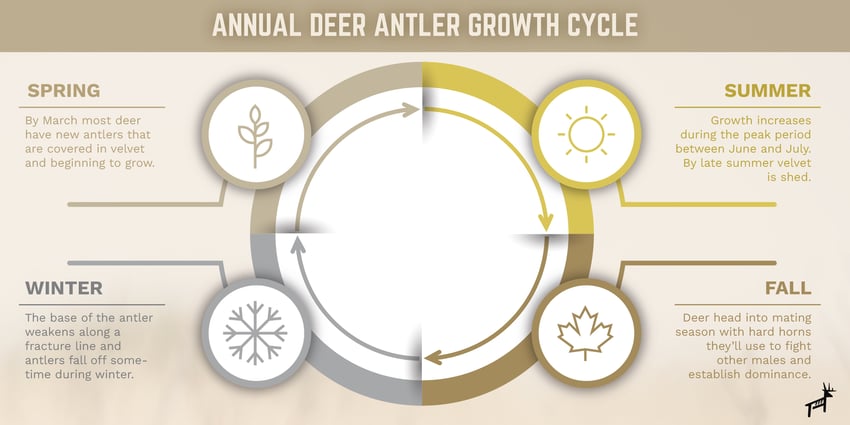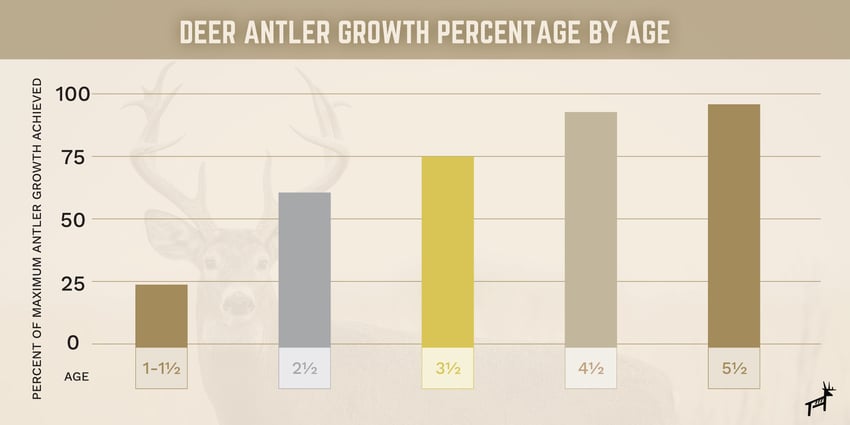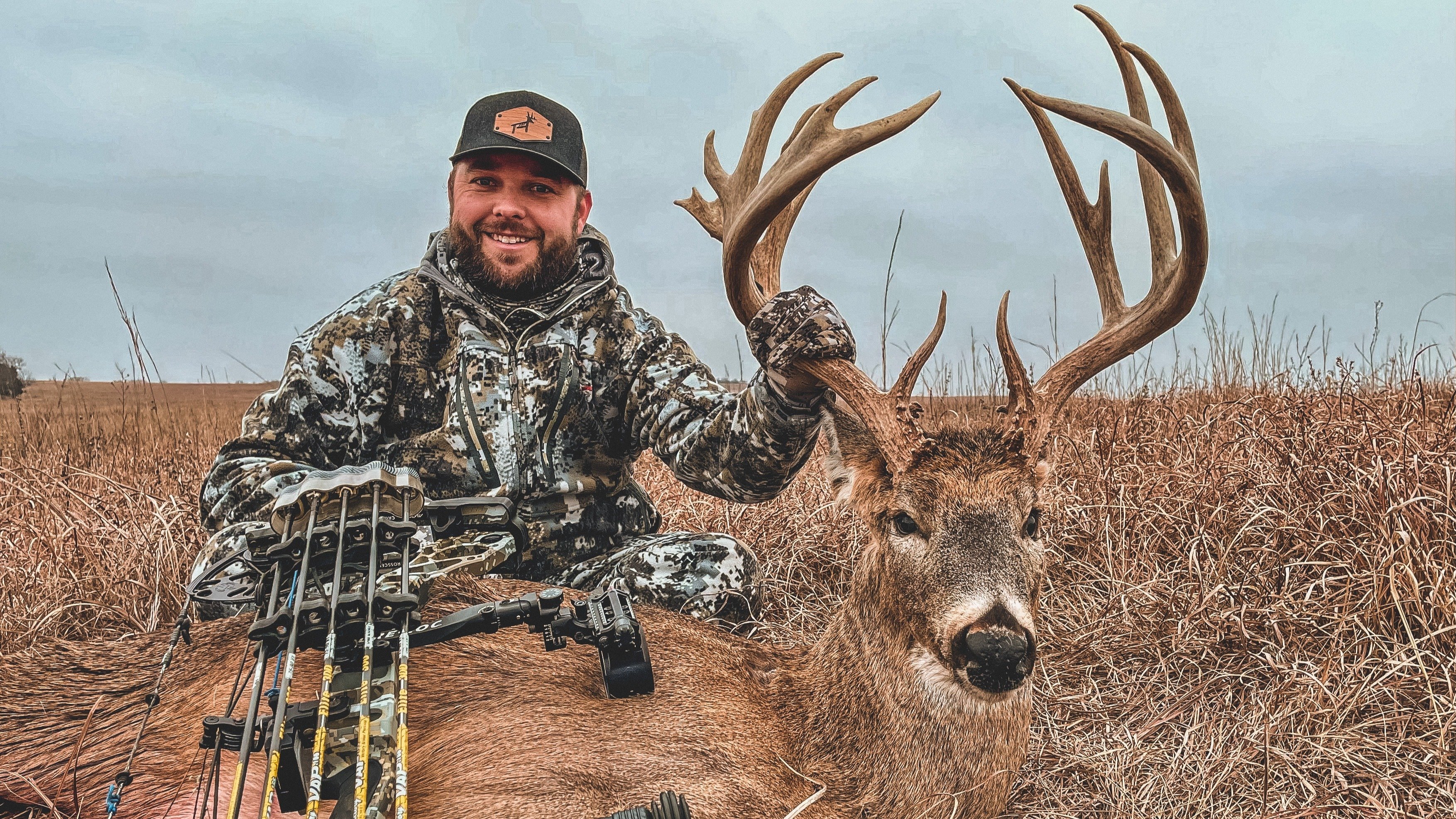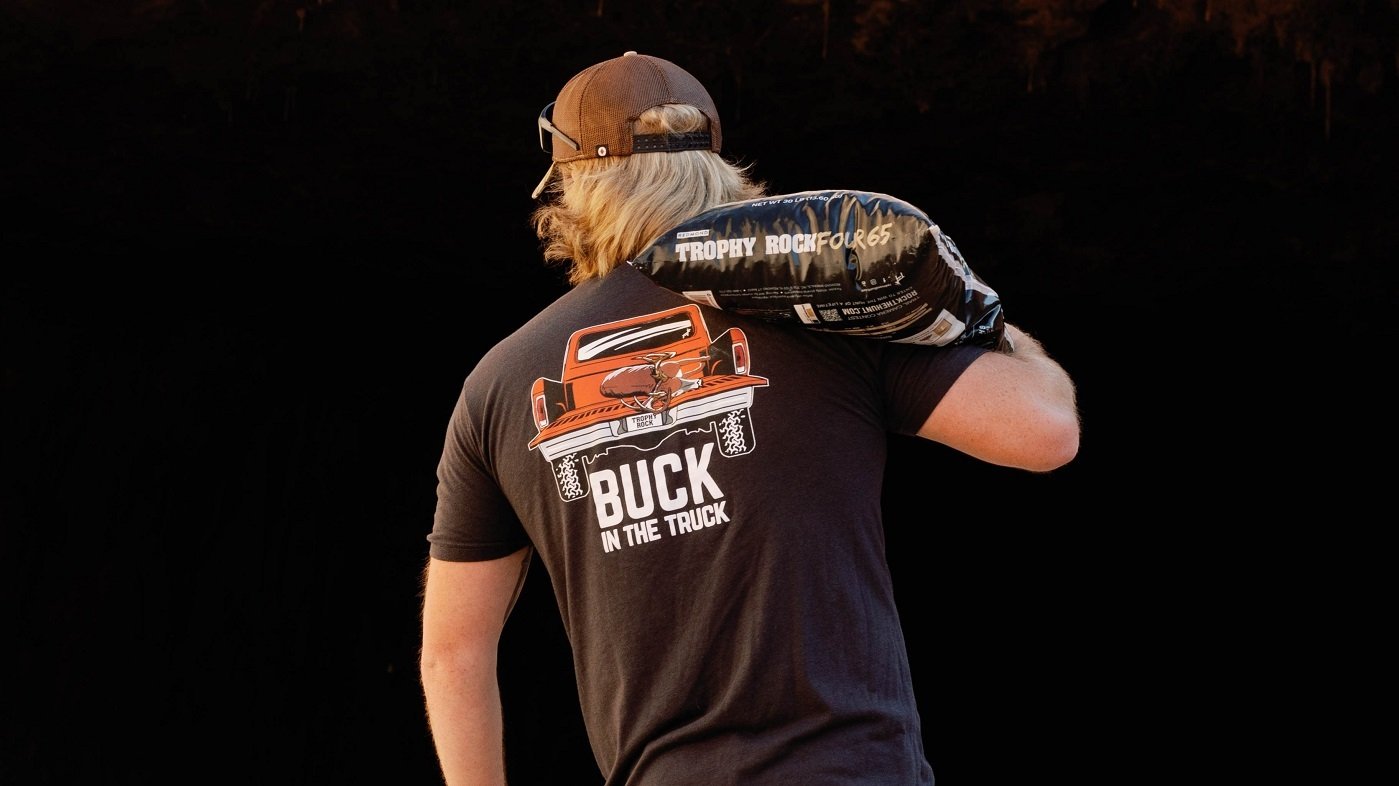Redmond Hunt Blog
3 Critical Factors that Fuel Deer Antler Growth
Redmond Hunt March 21, 2023
Learn about the deer antler growth cycle, ages and seasons for antler development and shedding, and how to provide the best minerals for antler growth.
There's nothing that gets a hunter's blood pumping like the sight of a mature buck sporting a giant rack. Antlers have fascinated hunters and enthusiasts since the dawn of time. Early native people once painted and chipped their forked figures onto stone walls, and today we photograph and mount them as trophies on our living room walls.
There’s just something about a buck’s gnarly set of antlers that doesn’t get old. And how those antlers grow and eventually shed—then repeat the process year after year—is a big part of the mystique. While you don’t need us to break down how antlers are made to know they’re awesome, understanding the cycle does add a new layer of respect.
So, pull up a seat and let’s take a closer look at antler development! We'll cover how deer antlers grow, what factors affect size, and how you can maximize antler growth in your own herd.
Deer Antler Growth Cycle
First, let's set the record straight—antlers are not made from keratin, ivory, hair, or wood, as some question. Deer antlers are made of actual bone consisting mainly of calcium and phosphorous. They grow from pedicles, or bases, on the front skull of male deer. Antlers aren't permanent fixtures; they're deciduous, meaning they’re cast off and grow back yearly. Let's review what actually happens to antlers seasonally and during their three stages of development.
Did You Know? If you’ve ever wondered if female whitetail deer grow antlers, the answer is yes, but it's rare. A female may occasionally grow antlers if her body produces too much testosterone, though they’re often small and thin or may only present as spikes. Research puts the occurrence at 1 in 10,000 deer or fewer.
 Actively Growing
Actively Growing
March is the month when bucks start growing antlers. This coincides with the arrival of spring and increased daylight which slows melatonin production and kicks off the journey of antler growth, which is no ordinary business!
The amount of bone a deer can sprout from its head is simply incredible. That's because antlers are the fastest growing tissue scientists know of. To put numbers to it, this Mississippi University article notes yearlings can add up to ¾ inch and adult bucks 1½ inches of new growth per week. When nutrition and conditions are just right, bucks can churn out more than 200 inches of bone growth in just 120 days.
During those four months, antlers are fully outfitted with nerves and blood vessels that feed the fast-growing tissue. They’re also covered with a fuzzy layer of skin called velvet. While “in velvet,” antlers are soft and susceptible to injuries that may cause deformities—which isn’t necessarily a bad thing. Most hunters and deer enthusiasts appreciate antlers with one-of-a-kind characteristics, like a daggerlike drop tine or unique kicker point.
Shedding Velvet
By late August, most whitetail deer have achieved maximum antler growth, and antlers begin to mineralize or harden. If you’re familiar with basic construction, the process is sort of like building a skyscraper. Author Matt Knox with the Virginia Division of Wildlife Resources explains.
“What is first built is the structure or frame or matrix. Think of pouring concrete; you must first build a form. That is what deer do. During the early summer, deer antlers are soft to the touch or spongy. Toward the middle of summer, as the form is being finished, the deer begins to ‘pour’ the bone.”
Finally, by early September, the blood vessels also fill up and stop nourishing the velvet, which shrinks and dies. It’s removed from antlers as bucks thrash their rack on vegetation to strip it and possibly curb the itchy sensation that comes from velvet die-off. Once the velvet peels, bucks have hardened, polished antlers they'll use as weapons heading into the fall rut. They’ll come in handy to fight off other males and establish the right to mate with females in the age-old struggle for dominance.
Casting Antlers
Why do deer shed their antlers? It's a good question. Deer spend months dumping loads of nutrients and siphoned minerals from their skeleton into building antlers. Then when mating season is over, they toss them off like yesterday’s empty acorn shells. However, there is method to this madness. Casting antlers yearly is necessary so bigger and better regrowth can happen—and so we can enjoy watching the fascinating process all over again.
So what causes antlers to be cast? By late December, the bone between the pedicle and the antler starts to demineralize along an abscission line. It’s basically like a bone fracture. This weakened base, combined with the top-heavy weight of the antler, eventually causes it to drop off. Sometimes both antlers may detach simultaneously—like in this spectacular trail cam video—or come off days or even weeks apart.
Seasoned bucks often shed antlers earlier than younger bucks, and deer in good condition typically hang onto antlers longer than those in poor shape (Virginia DWR). While the timing of antler drop varies, most cast sometime between December and early March. Afterward, the pedicle bleeds for a short time, heals within a few weeks, and new antler growth starts all over again.
Factors that Affect Antler Development
Three main components impact how large antlers grow: age, genetics, and nutrition. Deer hunters and stewards can only directly influence two, but we'll cover each.
Age
Age is a significant factor in what causes deer antlers to be bigger or smaller. Male fawns, known as “button bucks,” grow pedicle bumps at about two months old. However, their first noticeable set of antlers come as a yearling and may range from spikes to 10 or more points (University of Missouri). As a buck matures, his antlers get bigger and better developed until growth finally maxes out at 6½ years. The growth chart below shows what percentage of antler growth deer achieve by age.
Shooting young bucks aged three or under is one major reason antler size decreases in a herd. If your goal is to have bigger bucks on your hunting property, let young deer grow up and reach their potential. The photo collage below shows antler growth on a mature six-year-old deer tracked from 2014 (age three) through 2017 (age six) when he was finally harvested.

Genetics
A deer’s DNA is Mother Nature's handiwork and something humans can't control. Genetics are controlled by the makeup of a deer’s parents, which affects antler shape, composition, and size. However, ample high-quality nutrition—something humans can improve—is a must for deer to be able to reach their genetic potential. This video by Growing Deer TV features a Ph.D. student at Mississippi State University who contends that nutrition is actually the main factor for growing large, fully formed antlers, and genetics are secondary. So, let's cover more on nutrition and how deer managers can make their mark.
Nutrition
Antler growth is a physiologically demanding task. It requires huge amounts of nutrients, energy, and forage dense in protein and minerals. When deer don’t receive proper nutrition, body and antler size suffer.
Protein is especially important. The University of Missouri found that a difference of 8 percent and 16 percent protein in a buck’s diet through age 4 can potentially cause a 20-inch difference in antler size. That's the difference between a decent rack and a tale-worthy trophy.
So, what about minerals? Do minerals really help antler growth? Calcium and phosphorus are scientifically known to be important, and other minerals play a critical role as well. The National Deer Association noted a University of Georgia study found 11 different minerals in whitetail antlers. The top four included calcium (19 percent), phosphorus (10 percent), magnesium (1 percent), and sodium (0.5 percent).
Other trace minerals are also necessary. While deer only require trace minerals in very small amounts, wildlife biologist Dr. Grant Woods notes they are critical for bucks to achieve maximum antler growth. “It doesn’t take much of a trace mineral to benefit a deer,” Woods said. “But without access to trace minerals in their diet, bucks won’t be able to express their full antler growth and does won’t express their fawn-producing potential.”
How to Maximize Antler Growth
While some things are out of your control when it comes to growing bigger bucks, there are important factors you can implement on your farm or hunting property. Here are four:
- Maintain a healthy deer density and buck:doe ratio so deer aren’t overpopulated and competing for food. Generally, this means harvesting more does.
- Plant nutritious food plots that are high in protein, and fertilize appropriately. Conduct a soil test to determine low or missing minerals in your soil.
- Set up a year-round mineral site with quality supplements. You can learn how to set up a deer mineral site in this blog.
- Let young deer grow and harvest mature bucks over 4½ years old. (The deer in the collage below was photographed yearly from age 3 to age 6, when he was harvested.)
Best Deer Mineral for Antlers
Are you ready to grow bigger bucks? Providing quality minerals is an important step. The best mineral mix for deer is a supplement with balanced ratios of macro and trace minerals. Redmond Trophy Rock products contain 60+ minerals formed and balanced by nature. Our proven attractants and mineral supplements are preferred by deer, trusted by experts, and used by thousands of hunters.
Check out this May 2022 review from customer Cameron Baucom:
“The proof is in the minerals. For years my team and I have used Redmond products on our farms in North Carolina, Ohio, Kentucky, and Alabama. The herd retention, health, growth of bucks’ horns, and our harvest of mature whitetails have been outstanding. This is all because of Redmond products. 100% mined and produced here in the USA. I highly recommend them to any whitetail hunter looking for these results on their properties as well.”
 Provide deer with the balanced nutrients they need! Pick up your preferred Redmond Trophy Rock products and start improving antler growth and health in your herd today.
Provide deer with the balanced nutrients they need! Pick up your preferred Redmond Trophy Rock products and start improving antler growth and health in your herd today.
© Redmond Hunt 2023. All rights reserved.

.jpg?width=900&height=506&name=My%20project-1%20(7).jpg)


.jpg)
